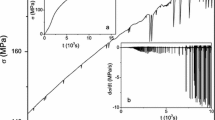Abstract
Brief description of a model of nucleation and motion of an ensemble of dislocations on the region of simulation is given; the algorithm of the operation of the model under a constant load is considered. Several families of strain-stress curves have been constructed at various parameters of the model, such as the number of dislocation sources, number of initial dislocations, lengths of the bases of the sources, number density of defects in the simulation region. Effects of these parameters on the shape of the deformation curves are illustrated.
Similar content being viewed by others
References
A. J. E. Foreman and M. J. Makin, “Dislocation Movement through Random Arrays of Obstacles,”. Can. J. Phys. 45(2), 511–517 (1967) [translated into Russian in Topical Problems of the Theory of Dislocations (Mir, Moscow, 1968), pp. 200–215]); see also Philos. Mag. 14, 911–924 (1966).
G. N. Dubnova, V. L. Indenbom, and A. A. Shtol’berg, “On the Bowing-out of a Dislocation Segment in a Frank-Read Source,” Fiz. Tverd. Tela 10, 1760–1768 (1968).
N. V. Stratan and A. A. Predvoditelev, “Simulation of the Dislocation Motion Process in a Dislocation Ensemble,” Fiz. Tverd. Tela 12, 1729–1733 (1970).
L. E. Popov, T. A. Kobotev, and V. S. Kovalevskaya, Plasticheskaya deformatsiya splavov (Plastic Deformation of Alloys) (Metallurgiya, Moscow, 1984) [in Russian].
V. I. Belan and A. I. Landau, “Net-Statistical Model of Dislocation Amplitude-Dependent Internal Friction,” Fiz. Met. Metalloved. 65, 259–266 (1988).
T. N. Golosova, M. I. Slobodskoi, and L. E. Popov, “Simulation of a Dislocation Source in the Field of Activated and Unactivated Discrete Obstacles,” Russ. Phys. J., No. 10, 912–916 (1992).
M. I. Slobodskoi, Issledovanie yavleniya skol’zheniya v kristallakh metodami imitatsionnogo modelirovaniya (Study of Slip in Crystals by Imitation Simulation Methods), Ed. by M. I. Slobodskoi and L. E. Popov (TGASU, Tomsk, 2004) [in Russian].
J. P. Hirth and J. Lothe, Theory of Dislocations (McGraw-Hill, New York, 1968; Atomizdat, Moscow, 1972).
V. V. Blagoveshchenskii and I. G. Panin, “An Increase in the Rate of Plastic Deformation under the Effect of Ultrasound,” Phys. Met. Metallogr. 103, 424–426 (2007).
V. V. Blagoveshchenskii and I. G. Panin, “Construction and Study of a Dynamical Model of Passing-By of Deffects by Dislocations in Crystals,” Izv. Vyssh. Uchebn. Zaved., Mater. Elektr. Tekhn., No. 2, 51–53 (2007).
P. I. Polukhin, G. Ya. Gun, and A. M. Galkin, Soprotivlenie plasticheskoi deformatsii metallov i splavov (Resistance of Metals and Alloys to Plastic Deformation), (Metallurgiya, Moscow, 1983) [in Russian].
Author information
Authors and Affiliations
Additional information
Original Russian Text © V.V. Blagoveshchenskii, I.G. Panin, 2012, published in Fizika Metallov i Metallovedenie, 2012, Vol. 113, No. 8, pp. 860–864.
Rights and permissions
About this article
Cite this article
Blagoveshchenskii, V.V., Panin, I.G. Investigation of plastic flow by the method of mathematical simulation of dislocation motion. Phys. Metals Metallogr. 113, 817–821 (2012). https://doi.org/10.1134/S0031918X12080030
Received:
Published:
Issue Date:
DOI: https://doi.org/10.1134/S0031918X12080030




